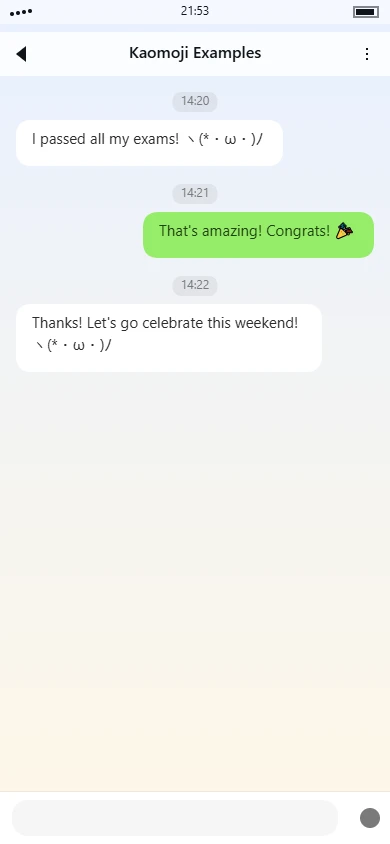(^▽^) kaomoji Meaning | Usage Tips

Overview
The kaomoji (^▽^) presents a straightforward facial expression composed of full-width characters that create a balanced, symmetrical face. The overall structure uses parentheses as the face outline, with two upward-curving caret symbols serving as eyes and a triangular mouth element in the center. This arrangement produces a clean, well-defined facial representation that appears somewhat stylized while remaining clearly recognizable as a smiling face.
The character composition relies on full-width versions of common ASCII symbols to achieve its visual effect. The full-width parentheses ( ) create a rounded facial boundary that appears more substantial than standard half-width parentheses. The eyes are formed by full-width caret symbols (^) which curve upward at both ends, suggesting lifted cheeks and a smiling expression. The mouth element (▽) is a full-width triangle pointing downward, which when placed between the upward-curving eyes creates the impression of a wide, open-mouth smile.
Symbol Breakdown
- Full-width parentheses ( ): Form the outer boundary of the face, creating a rounded shape that encloses the facial features
- Upward caret eyes (^): Positioned at the upper left and right, these symbols suggest raised eyebrows and smiling eyes
- Triangular mouth (▽): Located centrally between the eyes, this downward-pointing triangle represents an open smiling mouth
- Symmetrical arrangement: The balanced placement of elements creates a harmonious, centered facial expression
- Full-width character spacing: The wider character spacing compared to half-width characters gives the face a more open, expansive appearance
Emotion & Aesthetic Analysis
This kaomoji conveys a straightforward, cheerful happiness without excessive exaggeration. The upward-curving eyes combined with the open triangular mouth create an expression of genuine pleasure or satisfaction. The symmetrical arrangement and clean lines give it a somewhat polished, intentional appearance compared to more casual smiley faces.
The emotional tone is positive and friendly, suitable for expressing general happiness, agreement, or pleasant acknowledgment. It carries a slightly more formal or deliberate quality than simpler smileys like :) or (^_^), making it appropriate for contexts where a clear but not overly exuberant positive response is desired. The full-width characters contribute to a visually balanced presentation that works well in digital communication where clarity of expression is important.
Tag categories
Use tags to quickly understand this kaomoji.
Usage guide
The (^▽^) kaomoji is one of the most versatile and widely recognized happy faces in digital communication. Characterized by its upward-curving eyes and broad, cheerful smile, this emoticon conveys genuine happiness, friendliness, and positive energy. It's often used to express pure joy, warm agreement, or playful enthusiasm in casual online conversations. The balanced, symmetrical design gives it a universally appealing look that works well across various platforms from messaging apps to social media comments. Unlike more exaggerated happy faces, (^▽^) maintains a pleasant, approachable tone that's neither too intense nor too subtle, making it suitable for a wide range of positive interactions.
Use Cases
- Sharing exciting news with friends in a group chat
- Reacting to cute animal photos or funny memes
- Expressing genuine happiness when someone achieves something
- Responding positively to invitations or plans
- Showing appreciation for a thoughtful message or gift
- Celebrating small victories or accomplishments
- Greeting someone warmly at the start of a conversation
- Expressing cheerful agreement in casual discussions
- Reacting to pleasant surprises or unexpected good news
- Adding a friendly tone to compliments or praise
- Showing support and encouragement to friends
- Expressing contentment with how things are going
Examples
- Friend sharing good news: "I just got the job! (^▽^)"
- Planning meetup: "Saturday works perfectly for me! (^▽^) What time should we meet?"
- Reacting to photos: "Your dog is absolutely adorable in that costume! (^▽^)"
- Expressing gratitude: "Thanks so much for helping me move yesterday! (^▽^) I owe you one!"
- Celebrating achievements: "You finished the project early? That's amazing! (^▽^)"
- Morning greeting: "Good morning! Ready for a great day? (^▽^)"
Notes
- Avoid using this kaomoji in formal or professional communications where a more restrained tone is appropriate
- While generally positive, the intensity of happiness conveyed might be too strong for somber situations or serious discussions
- In some contexts, overusing this emoticon might make your messages appear less sincere or overly enthusiastic
- Be mindful that the cheerful tone might not match the mood if someone is sharing difficult news or expressing concerns
This kaomoji works particularly well in Japanese and Korean online communities where it originated, but has become widely understood in global digital communication. Its balanced expression makes it suitable for both personal and lighthearted professional contexts when used appropriately.
Usage examples
Real conversation samples that feature this kaomoji.

Example 1

Example 2
Related kaomoji
You might also enjoy these kaomoji.